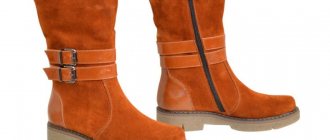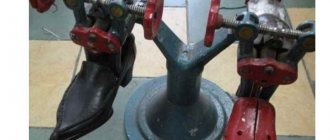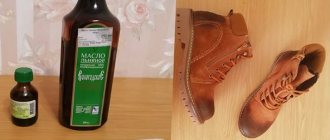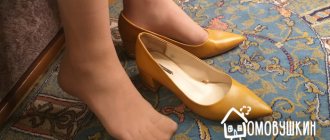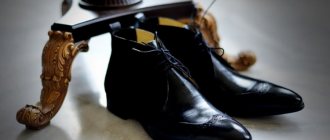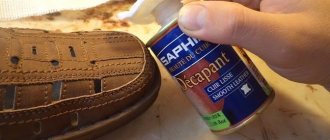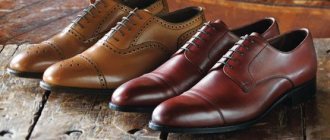Knowing how to prevent your winter and fall shoes from getting wet will help extend their lifespan and relieve the discomfort associated with wearing them. Firstly, it is worth assessing whether there are any flaws in the sole. Otherwise, dry thoroughly, avoiding direct contact with heating devices, then lubricate the surface with Aquabron, Salamander, Colonil or a warm family of waxes, fats and linseed oils.
In winter, even new shoes begin to get wet, so you will have to throw them away or restore the protective layer. To extend the life of your shoes, you need to correctly assess their condition, know how to wet your shoes and how to prepare the surface for treatment.
Why do boots get wet in winter?
- The sole has come off. Most often, such a “wet matter” is associated precisely with damage to the sole or its poor-quality “adhesion” to the boot itself.
- Poorly made shoes. Cheap boots “2 pairs for the price of 1” are always of poor quality. Manufacturers use low-quality materials, and the production process leaves much to be desired. Considering that suede and leather themselves do not allow moisture to pass through, we can confidently talk about poor-quality seams or the presence of holes and cracks.
- Chemical reagents. They are used to sprinkle roads in the winter, and it’s no secret that such products can “kill” even the strongest boots in one winter.
- Lack of special impregnation on shoes (note: the manufacturer’s task).
- Synthetic materials. Frost causes artificial leather and other synthetic materials to crack, as a result of which shoes also lose their “moisture resistance.”
So that when winter begins you don’t have to urgently fork out money for a second pair of shoes, purchase them in advance .
What shoes don't slip in winter?
How to properly dry wet boots
Direct contact of shoes with heating devices quickly removes moisture, but causes the adhesive to dry out excessively, resulting in wet product and damage to the sole. Eliminating defects in a workshop is only possible when the effect does not last long, especially if you still dry your shoes incorrectly.
How to dry shoes correctly:
- fill the bags with salt and place them in the toe of the shoe - the salt will absorb moisture without damaging the shoe;
- use special dryers - they are heated to the optimal temperature without damaging the shoes;
- place it on a heated floor;
- dry the inside with a hairdryer.
As a result of drying, the seam and glue retain their properties. But at the end of the day, keep your shoes dry to restore their protective layer.
Prepare your first pair for winter with the help of simple tips and specialists from a shoe workshop:
- We evaluate the integrity of the sole, seams, leather and accessories.
- We wash and clean the surface.
- We change heels (if necessary) and strengthen the heels.
- We sew (strengthen) the seams.
- Reinforce (if necessary) the sole. This preventive measure will help compact the sole, protect it from rapid abrasion and provide anti-slip properties. It is important to ensure that the master uses only high-quality material that will be resistant to reagents and frost. For example, wear-resistant rubber or polyurethane. Such a budget option as resit (note – and microporous rubber) should be abandoned.
Tips for using impregnations
It is convenient to use old toothbrushes to clean shoes before soaking. They will help remove all dirt from seams and hard-to-reach areas. Consequently, the quality of moisture-proof treatment will be higher. If the shoes are heavily soiled, wipe the shoes with a sponge and a solution of laundry soap, then rinse with water and dry.
Cleaning shoes with a toothbrush
Regardless of the type of impregnation and its composition, you can pre-heat your shoes with a hairdryer. This way the product will be absorbed into the skin faster and will not appear on the surface.
Advice! Typically, homemade wax-based impregnating compounds are applied in a thick layer. Don't be afraid that white stains remain on the surface - you can also walk over them with hot air from a hairdryer, and the excess composition will disappear.
There is no need to go outside immediately after treating your shoes. It is better to leave it to dry overnight, or not to touch it for at least several hours. As the composition wears off, a new portion is applied.
Self-made impregnations will save money and extend the life of shoes, and will also help to always keep your feet warm and dry!
You can also...
- Impregnate poor-quality seams with a special agent with water-repellent properties. True, this manipulation will have to be repeated periodically.
- Dry the cracks and holes (note - sand the surface, and then apply drying oil and wait for it to dry).
- Install outsoles (rolling) on top of your sole if you do not want to change it completely.
- Buy fat-containing (nutrient) products for leather shoes. They will restore elasticity to the boots and prevent cracking.
- Buy creams/aerosols based on beeswax for patent leather shoes.
- Find special products for shoes with breathable membranes. Such products will enhance the water-repellent effect and support pore breathing.
How to choose the right shoe size - tables of all shoe sizes for adults
Method of treatment against wetting
To make shoes waterproof, you should use household cleaning products (folk) or special impregnations.
The principle of their use is similar:
- prepare for impregnation,
- Dry the inside thoroughly and clean it from street dirt.
- Cover the outside with a thin layer of the selected product.
The dried product forms a thin skewer that will protect the shoes from getting wet. Some of them additionally color the surface, hiding imperfections and restoring its attractiveness.
Ready-made water-repellent products for shoes. Professional products allow you to treat shoes made of suede or natural nubuck, leather. Choose water repellents based on the material your shoes are made from. Then the treatment will be as effective as possible.
Attention! Products for the production of leather goods are absolutely not suitable for suede, as they irreversibly spoil the appearance of the material, and substances for nubuck are not effective enough when processing leather products.
The most popular impregnations of shoe manufacturers:
- Aqua booking;
- Salamander.
They are sold in a bottle with a foam brush, which makes it easy to apply, evenly distributed over the surface and provides excellent protection from water and product stains. They are made to handle velor, fur, suede and leather come in a wide variety of colors. Therefore, when purchasing impregnation, you should carefully read the description.
Strengthening the water-repellent properties of leather shoes: 7 best “folk” recipes
- Lamb lard (about 50 g) + flax oil (about 50 g) + regular turpentine (10 g). Mix the ingredients, having previously melted the lard, and apply the still warm mixture to the boots using a soft cloth.
- Wax + flax oil. Melt 30 g of wax (you can use paraffin) over low heat and mix with pre-purchased linseed oil (10 g is enough). Apply the warm mixture to the boots and gently rub in with a woolen cloth.
- Castor oil. As a rule, every girl has it. But it is recommended to use it exclusively for rough skin (note: it will ruin thin skin). Simply rub the oil into the leather surface and polish.
- Beeswax (about 20 g) + regular turpentine (about 10-15 g) + crushed rosin (no more than 50 g). Mix all ingredients and apply to boots with a soft cloth. Wait for absorption.
- Glycerin (about 20 g) + liquid fish oil (40 g) + turpentine (about 30 g) + beeswax (about 10 g). Mix everything, melt over low heat and mix with glycerin. Next, apply the mixture to the shoes.
- Castor oil + any animal fat. We take these components in equal proportions, after melting the fat. Next, mix them and apply the mixture to the shoes and their seams.
- Wax or paraffin. Rub the boots with a candle until the surface is completely covered. Next, we heat this wax coating evenly using a hairdryer. An ingenious recipe that reliably saves shoes from getting wet.
Professional water repellents
Shoe store shelves are full of a variety of products to protect your skin from getting wet. Some boot manufacturers include a cream or spray in the box with a pair that is recommended for a specific product. In this case, remember the name and then purchase only that.
Spray
If your shoes get wet, store-bought water-repellent sprays will help solve the problem. You need to soak your boots every time before going outside. As stated in the description, the spray reliably protects the material from moisture, preventing it from penetrating inside.
There are a lot of aerosols sold in the shoe department, here are the best ones:
- Salamander;
- Ecco;
- Collonil Nanopro;
- Kiwi Aqua Stop.
Each brand has products for different shoe materials. Salamander and Ecco are intended for suede, genuine leather, textiles. Collonil Nanopro and Kiwi Aqua Stop are universal sprays that are suitable for textiles, velor, dermantine, leather and nubuck.
Important! Silicone-based sprays are only suitable for smooth skin. For other materials, fluorine-containing products are used.
Cream
Fat creams care for the surface, nourish it, and create a protective layer that prevents getting wet.
The stores sell impregnation creams of different brands. Recommended products:
- Salamander;
- Grangers G-Wax;
- SMS Olvist.
They contain lipids, beeswax, and other fat-containing components. The cream protects boots from getting wet, gives them shine, eliminates signs of wear, and covers up scuffs.
Advice! To avoid getting wet, you need to treat your shoes every day. Impregnations with wax and silicone are quickly washed off, especially in humid, rainy weather.
Wax
You can treat your shoes so they don't get wet using shoe wax. It is recommended only for leather and varnished surfaces.
The following varieties exist:
- bee;
- pressed;
- extraction;
- bleached.
A soft, delicate product is obtained from bee, and bleached is used for hard, rough skin. Coloring agents are added to the wax, so it easily replaces colored shoe polish.
Most often, wax is used when you need to “heal” shoes with cracks and creases. It gently softens cracked areas and makes them invisible.
Natural fiber brushes or a medium-hard sponge will help you apply the wax correctly. Procedure:
- Wash and dry your shoes.
- Scoop up a little product with a brush.
- Rub it into the material in a circular motion, starting from the sock.
Important! After applying the wax, be sure to warm it up with a hairdryer so that it penetrates deep into the skin.
It is also important to apply it correctly!
- Method of 3rd application of impregnation. We apply the product to shoes three times with an interval between procedures of 1 day. Only after such a procedure can you be sure of the reliability of your shoes.
- Using a spray, we spray it not with one “spray” , but until the product stops being absorbed into the structure of the shoe.
- When using impregnation on old shoes, we first thoroughly clean the surface of the shoe, then wash it and dry it thoroughly. And only then can you apply the product.
- Choosing the right product! For example, oily water-repellent creams are only suitable for rough leather, while for other materials it is better to use sprays and emulsions. It is also worth noting that leatherette is not able to absorb oils and sprays.
The easiest way
For moisture-proof treatment, products can be lubricated with ordinary petroleum jelly, which is sold in every pharmacy. Just take a soft cloth, apply a little cosmetic product to the surface and rub in well.
Afterwards, shoes should not be worn for several hours so that the Vaseline can be completely absorbed. This impregnation will last for several days.
Treating shoes with Vaseline
Important!
If you purchased expensive shoes for the winter, and they got wet in the first week of winter, you have every right to contact the seller and demand a refund or an equivalent exchange .
It is recommended to keep the receipt!
If the seller refuses, according to the law, you can insist on an independent examination procedure and sue, demanding reimbursement of all your costs, the amount spent on shoes, as well as payment for moral damages.
The site Colady.ru thanks you for your attention to the article! We will be very pleased if you share your recipes for making boots or shoes waterproof!
Causes of this problem
It happens that even good expensive shoes begin to get wet. Sometimes this is due to improper storage or care, and sometimes due to manufacturing errors. The most common reasons for boots getting wet are the following:
- Poor quality of materials. To provide all people with affordable shoes, manufacturers make shoes from cheap materials. Very often, such boots crack, fall apart, their soles fall off, and the locks break.
REFERENCE! All this happens due to poor quality shoe assembly at the factory.
- The sole came off. If you wear shoes for a long time, the glued sole cannot withstand it and comes off. With stitched shoes, this problem occurs less often.
- Exposure to chemicals. In winter, the road is sprinkled with chemical reagents, thanks to which the ice disappears. However, this spoils boots, even the best ones.
- Synthetic composition, which cracks due to temperature changes and moisture. Shoes made from leather and leatherette substitutes become fragile and allow water to pass through.
If it's all about the sole
Does careful care not save your feet from getting wet? Probably the sole is to blame. Poor connection to the shoe ensures that moisture gets inside the shoe. Companies that are reputable on the market do not have this problem, and if you save on shoes, then do not skimp on their repair and protection. Saturate the joints of the sole with water-repellent agents, although you will have to treat it regularly. For this you can use animal fat, wax, paraffin, castor oil.
Or use the experience of our grandmothers and make your own shoe polishes. Castor oil is an excellent remedy for protecting stitches and skin:
- 0.5 tsp turpentine, 4 tsp. linseed oil, turpentine, fish oil,
- a teaspoon of paraffin, wax and linseed oil.
Mix 1k1 castor oil and animal fat. Instead of flaxseed oil, you can use waterfowl fat.
Attention! These products are not suitable for suede shoes.
Paraffin or beeswax
This is perhaps the most famous and “old” method. To use it, you will need a colorless paraffin candle, beeswax or other wax, or, as a last resort, a wax crayon for drawing (the same color as the shoes, or a little darker). The frequency of use of this method is 6-8 months.
Step by step steps:
- Use a piece of wax or paraffin to “walk” over the entire surface of the shoe. There should be no empty gaps left, otherwise it is through them that moisture will penetrate.
- Heat the applied wax using a home hair dryer. It will melt and cover the shoes with a thin protective layer.
Important! The seams should also be lubricated with paraffin to protect them from moisture penetration. If the shoes have been processed correctly, the applied wax will not crack after heating. Otherwise, you should heat it again until it melts and the cracks disappear.
What can I do to make my boots softer?
Stretch the boots
You can stuff them with finely cut newspapers, which should be filled with water and left for 12 hours. There is a cowboy method - when grain or other swelling grains are poured into shoes and filled with water. No one has canceled the professional methods of stretching for shoemakers using special lasts.
Interesting materials:
How to distribute beds in the garden? How to distribute lamps on a tension lamp? How to plant clematis in spring? How to calculate aluminum heating radiators per area? How to calculate aluminum radiators? How to calculate the annuity payment for early repayment? How to calculate an arch for a greenhouse? How to calculate reinforcement for a foundation? How to calculate reinforcement for a strip foundation? How to calculate azimuth?
Caring for shoes made from other materials
If you are dealing with wet non-leather shoes, then no store-bought care will do. The thing is that using oil or sprays on leatherette is pointless, since it does not absorb water or fat, and on fabric it is simply stupid. It turns out that nothing can protect you from getting your fabric sneakers wet, but leatherette shoes can still be saved.
We mentioned that leatherette itself does not absorb moisture, which means that the problem most likely lies in a poorly glued, poorly sewn or damaged sole, which brings us back to the very first point of discussion. You already know what you need to do: take care of the soles, and you can wear the boots for a long time without the risk of getting your feet wet.
Having these simple means and methods for caring for your boots in your arsenal, you will no longer catch a cold due to an oversight by the shoe manufacturer or bad weather.
